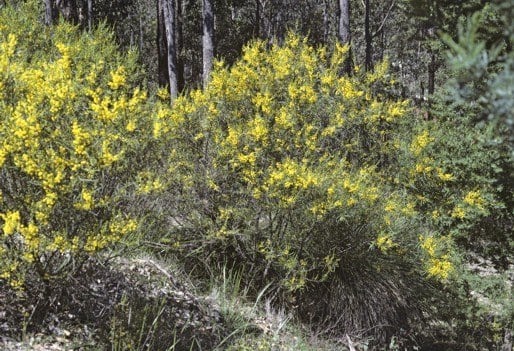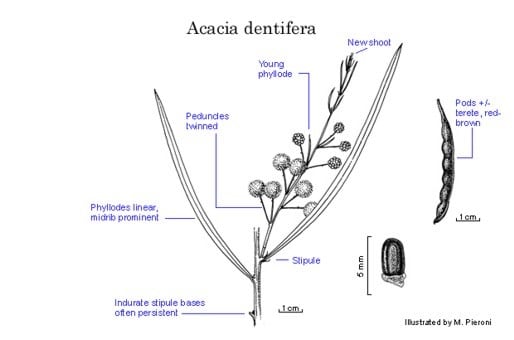Acacia dentifera Benth.
WATTLE
Acacias of Australia
Common Name
Tooth-bearing Acacia
Family
Fabaceae
Distribution
Found from the Helena Valley near Perth, S to near Bridgetown with one collection from Warriup Hill. c. 50 km NE of Albany, south-western W.A.
Description
Shrub 2–3 m high. Branchlets straight, brown-dotted, glabrous. Stipules persistent but sometimes only bases remaining as indurate tooth-like projections at old nodes. Phyllodes linear, sometimes narrowly elliptic, ±straight to shallowly curved, 7–15 cm long, 2–5 mm wide, acute, mucronate, thin, green, glabrous, punctate by circular red-brown resin-hairs when young; midrib prominent; lateral nerves absent or obscure; gland commonly absent; pulvinus 0.5–1 mm long. Inflorescences simple but initiated on new shoots which sometimes resemble terminal racemes; peduncles twinned, 1–2 cm long, glabrous, with a ±caducous bract near or above middle, ebracteate at base; heads globular to obloid, 30–45-flowered, golden. Flowers 5-merous; sepals ±free. Pods ±terete, slightly constricted between seeds, to 6.5 cm long, 3–4 mm wide, thinly coriaceous, red-brown, obscurely longitudinally reticulate, glabrous. Seeds longitudinal, oblong, 3.5–4.5 mm long, semi-glossy, dark brown; aril white.
Habitat
Grows in granitic or lateritic soil, loam, clayey sand over granite and clay, often near watercourses or granite rocks in temperate Eucalyptus forest.
Specimens
W.A.: Swan R., J.Drummond s.n. (K, MPU) and coll. 2, no. 298 (BM, G, K, P); Warriup Hill, S coast NE of Albany, K.Newbey 2627 (PERTH); near Maddington, Canning R., L.Preiss 932 (BM, C, FI, K, LUND, M, MO, NAP, RO (sphalm ‘787’) & TCD (sphalm ‘787’).
Notes
Closely allied to A. graniticola and A. tuberculata, and more distantly to A. nodiflora. Superficially similar to A. dietrichiana from Qld, which is recognised especially by its viscid branchlets, generally longer phyllodes, minute raceme axes and exarillate seeds.
The specimen, J.Drummond 5: 7, cited by G.Bentham, Fl. Austral. 2: 261 (1864), is A. veronica. Also, Bentham erroneously described the aril colour of A. dentifera as orange.
This species, like A. trigonophylla, is unusual in that the aril faces the base, rather than the apex of the pod.
FOA Reference
Data derived from Flora of Australia Volumes 11A (2001), 11B (2001) and 12 (1998), products of ABRS, ©Commonwealth of Australia
Author
B.R.Maslin
Minor edits by J.Rogers
This identification key and fact sheets are available as a mobile application:
URL: https://apps.lucidcentral.org/wattle/
© Copyright 2018. All rights reserved.









